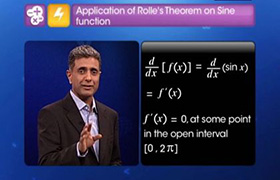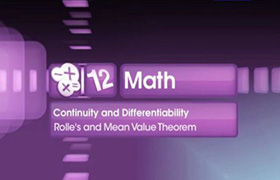CBSE Class 12-science Answered
Discuss the applicability of Rolle’s theorem on the function f (x) = 

Asked by Topperlearning User | 04 Aug, 2014, 16:11: PM
Since a polynomial function is everywhere continuous and differentiable. Therefore, f (x) is continuous and differentiable at all points except possibly at x = 1.
Now, we consider the differentiability of f (x) at x = 1.
We have,
(LHD at x = 1) = 

[f (x) = x2 + 1 for 0 ≤ x ≤ 1]
(RHD at x = 1) = 

\ (LHD at x = 1) ¹ (RHD at x = 1)
So, f (x) is not differentiable at x = 1.
Thus, the condition of a differentiability at each point of the given interval is not satisfied.
Hence, Rolle’s theorem is not applicable to the given function on the interval [0, 2].
Answered by | 04 Aug, 2014, 18:11: PM
Concept Videos
CBSE 12-science - Maths
Asked by Topperlearning User | 04 Aug, 2014, 15:57: PM
CBSE 12-science - Maths
Asked by Topperlearning User | 04 Aug, 2014, 16:00: PM
CBSE 12-science - Maths
Asked by Topperlearning User | 04 Aug, 2014, 16:03: PM
CBSE 12-science - Maths
Asked by Topperlearning User | 04 Aug, 2014, 16:11: PM
CBSE 12-science - Maths
Asked by Topperlearning User | 04 Jun, 2014, 13:23: PM
CBSE 12-science - Maths
Asked by Topperlearning User | 05 Aug, 2014, 08:38: AM
CBSE 12-science - Maths
Asked by Topperlearning User | 04 Aug, 2014, 15:32: PM
CBSE 12-science - Maths
Asked by Topperlearning User | 04 Aug, 2014, 15:48: PM
CBSE 12-science - Maths
Asked by Topperlearning User | 04 Aug, 2014, 16:16: PM
CBSE 12-science - Maths
Asked by Topperlearning User | 04 Aug, 2014, 16:35: PM





 on [– 2, 2].
on [– 2, 2]. on [a, b], where 0 < a < b.
on [a, b], where 0 < a < b.
